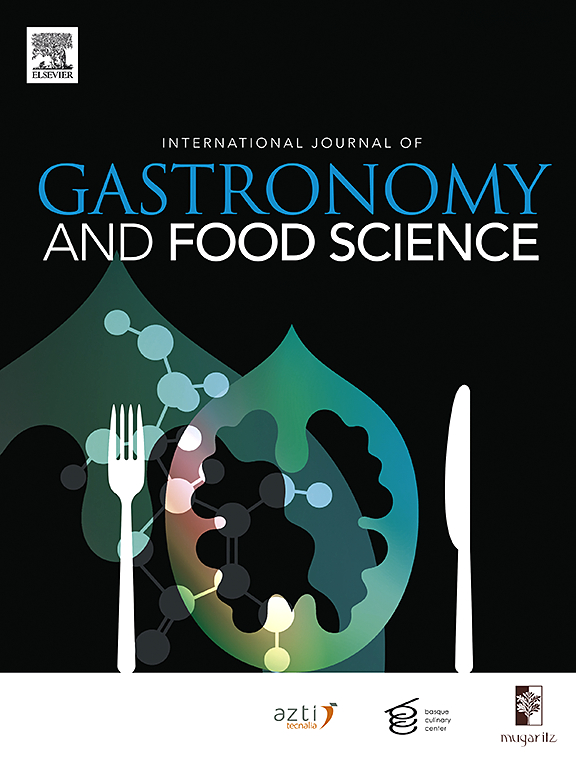Exploring the unique characteristics of Bora rice: A key ingredient in Assamese cuisine and its comparative analysis
IF 3.6
2区 农林科学
Q2 FOOD SCIENCE & TECHNOLOGY
International Journal of Gastronomy and Food Science
Pub Date : 2025-06-19
DOI:10.1016/j.ijgfs.2025.101233
引用次数: 0
Abstract
The study compared physical, cooking, proximate, physicochemical, and pasting properties of Aijong and Bora rice varieties to assess their suitability for making traditional Assamese snacks like tilpitha. Aijong rice showed the highest sphericity, bulk density, amylose, and protein content, along with the greatest elongation ratio and water uptake during cooking, resulting in a firmer texture due to its high amylose content. Bhogali rice had the lowest values for these traits and the lowest fat content. Bora rice varieties, characterized by low amylose and high amylopectin, were stickier and less firm after cooking, making them more suitable for sticky snacks. Physicochemical analysis revealed that the water solubility and absorption indices were influenced by amylose content, with Bhogali having the highest water solubility and Aijong the lowest. X-ray diffraction showed Aijong had the highest crystallinity. In pasting properties, Bhogali rice had the highest peak viscosity, making it too firm for pitha, while the Nal Bora variety, with intermediate pasting and setback viscosity, offered the best balance of firmness and stickiness for tilpitha preparation. Overall, the findings guide the selection of rice varieties for specific food processing needs, especially for traditional Assamese snacks.
探索博拉米的独特特征:阿萨姆邦美食的关键成分及其比较分析
该研究比较了Aijong和Bora水稻品种的物理、烹饪、近似、物理化学和糊化特性,以评估它们是否适合制作传统的阿萨姆邦小吃,如tilpitha。爱宗大米的球度、堆积密度、直链淀粉和蛋白质含量最高,蒸煮过程中的伸长率和吸水率也最高,由于直链淀粉含量高,质地更坚固。Bhogali水稻的这些性状值最低,脂肪含量最低。博拉稻品种直链淀粉含量低,支链淀粉含量高,经蒸煮后较粘,硬度较低,更适合制作粘性小吃。理化分析表明,直链淀粉含量对水溶性和吸收指标均有影响,其中博加利水溶性最高,爱宗水溶性最低。x射线衍射结果表明,爱钟的结晶度最高。在糊化性能方面,Bhogali水稻的黏度峰值最高,对果皮来说过于坚硬,而Nal Bora品种的黏度适中,为果皮的制备提供了最好的硬度和黏性平衡。总的来说,研究结果指导了特定食品加工需求的大米品种选择,特别是传统的阿萨姆邦小吃。
本文章由计算机程序翻译,如有差异,请以英文原文为准。
求助全文
约1分钟内获得全文
求助全文
来源期刊

International Journal of Gastronomy and Food Science
Social Sciences-Cultural Studies
CiteScore
5.30
自引率
10.50%
发文量
170
审稿时长
45 days
期刊介绍:
International Journal of Gastronomy and Food Science is a peer-reviewed journal that explicitly focuses on the interface of food science and gastronomy. Articles focusing only on food science will not be considered. This journal equally encourages both scientists and chefs to publish original scientific papers, review articles and original culinary works. We seek articles with clear evidence of this interaction. From a scientific perspective, this publication aims to become the home for research from the whole community of food science and gastronomy.
IJGFS explores all aspects related to the growing field of the interaction of gastronomy and food science, in areas such as food chemistry, food technology and culinary techniques, food microbiology, genetics, sensory science, neuroscience, psychology, culinary concepts, culinary trends, and gastronomic experience (all the elements that contribute to the appreciation and enjoyment of the meal. Also relevant is research on science-based educational programs in gastronomy, anthropology, gastronomic history and food sociology. All these areas of knowledge are crucial to gastronomy, as they contribute to a better understanding of this broad term and its practical implications for science and society.
 求助内容:
求助内容: 应助结果提醒方式:
应助结果提醒方式:


